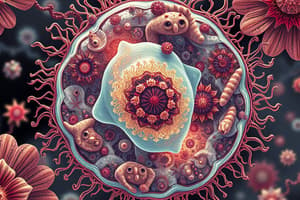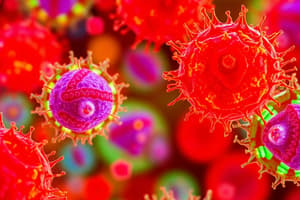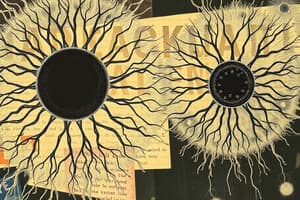Podcast
Questions and Answers
Which of the following best illustrates the concept of natural selection?
Which of the following best illustrates the concept of natural selection?
- A type of bacteria that has not changed in millions of years.
- A group of birds where those with longer beaks are more successful at getting food and produce more offspring. (correct)
- A species of fish that lays the same number of eggs each season.
- A population of trees that all grow to the same height.
How do ecological interactions influence ecosystems?
How do ecological interactions influence ecosystems?
- They only impact populations at the top of the food chain.
- They have no impact.
- They shape the structure and dynamics of the ecosystem. (correct)
- They only influence the non-living components.
Which of the following options would be categorized as a behavioral adaptation?
Which of the following options would be categorized as a behavioral adaptation?
- The thick fur of a polar bear.
- The migration of birds during winter. (correct)
- The sharp teeth of a shark.
- The development of camouflage patterns in insects.
What is a key factor that guides the classification of organisms into different kingdoms?
What is a key factor that guides the classification of organisms into different kingdoms?
What evidence could a scientist use to support the theory of evolution?
What evidence could a scientist use to support the theory of evolution?
Which of the following best describes the primary distinction between prokaryotic and eukaryotic cells?
Which of the following best describes the primary distinction between prokaryotic and eukaryotic cells?
In a cell, what is the primary function of the mitochondria?
In a cell, what is the primary function of the mitochondria?
What is the significance of chromosomes in genetics?
What is the significance of chromosomes in genetics?
Which of the following is an example of a non-Mendelian inheritance pattern?
Which of the following is an example of a non-Mendelian inheritance pattern?
Which term best describes the variety of life in a given area?
Which term best describes the variety of life in a given area?
What is the primary source of energy for most ecosystems?
What is the primary source of energy for most ecosystems?
Which of these is the study of interactions between living organisms and their environment?
Which of these is the study of interactions between living organisms and their environment?
What best describes the flow of energy within an ecosystem?
What best describes the flow of energy within an ecosystem?
Flashcards
What are cells?
What are cells?
The basic building blocks of all living things responsible for carrying out life processes.
What are prokaryotic cells?
What are prokaryotic cells?
Cells that lack a nucleus and membrane-bound organelles, such as bacteria.
What are eukaryotic cells?
What are eukaryotic cells?
Cells that contain a nucleus and membrane-bound organelles, found in plants, animals, fungi, and protists.
What is genetics?
What is genetics?
Signup and view all the flashcards
What are genes?
What are genes?
Signup and view all the flashcards
What is an ecosystem?
What is an ecosystem?
Signup and view all the flashcards
What is the flow of energy in an ecosystem?
What is the flow of energy in an ecosystem?
Signup and view all the flashcards
What is ecology?
What is ecology?
Signup and view all the flashcards
Adaptation
Adaptation
Signup and view all the flashcards
Natural Selection
Natural Selection
Signup and view all the flashcards
Kingdom
Kingdom
Signup and view all the flashcards
Evolution
Evolution
Signup and view all the flashcards
Common Ancestry
Common Ancestry
Signup and view all the flashcards
Study Notes
Introduction to Science 3rd Quarter
- The 3rd quarter typically focuses on life science, covering concepts about living organisms.
Life Science: Cells
- Cells are the fundamental units of life, responsible for various life processes.
- Cells are categorized as prokaryotic (lacking a nucleus and membrane-bound organelles) or eukaryotic (possessing a nucleus and membrane-bound organelles).
- Eukaryotic cells, found in plants, animals, fungi, and protists, are more complex than prokaryotic cells, often containing specialized components with distinct functions.
- Cell organelles have roles such as energy production (mitochondria), protein synthesis (ribosomes), DNA storage (nucleus), and waste removal.
- Cell membranes regulate what enters and exits the cell.
- Cell division is crucial for growth, repair, and reproduction of organisms.
Life Science: Genetics
- Genetics explores hereditary mechanisms and inheritance patterns.
- Genes, segments of DNA, transmit traits across generations.
- DNA's double helix structure carries genetic information.
- Chromosomes are DNA and protein structures that arrange and store DNA.
- Mendelian genetics describes basic heredity principles.
- Non-Mendelian inheritance patterns (incomplete dominance and codominance) exist beyond simple dominant/recessive mechanisms.
- DNA mutations create genetic variations that can contribute to evolution.
Life Science: Ecosystems
- Ecosystems involve interactions between living and non-living components.
- Biotic (living) components include organisms, and abiotic (non-living) components include factors like sunlight and water.
- Food chains and food webs demonstrate energy flow among organisms.
- Ecological interactions (predation, competition, and symbiosis) shape the ecosystem.
- Biodiversity, the variety of life, affects ecosystem health and stability.
- Energy flows through ecosystems in one direction, usually from the sun.
Life Science: Ecology
- Ecology examines the relationships between living organisms and their environment, studying populations, communities, ecosystems, and the biosphere.
- Ecological factors (climate, nutrients, and resources) determine ecosystem properties and balance.
- Ecological interactions (like competition and predation) influence ecosystem structure and dynamics.
Life Science: Adaptation
- Living organisms have adaptations enabling survival in specific environments.
- Adaptations can be structural, behavioral, or physiological traits.
- Natural selection favors individuals with advantageous traits.
- Adaptations, genetic mutations, and environmental changes contribute to life's diversity.
Life Science: Diversity of Organisms
- Various organisms exist across different kingdoms (plants, animals, fungi).
- Each kingdom possesses distinct characteristics and adaptations.
- Classification systems organize organisms based on shared traits and evolutionary history.
- Plant and animal adaptations exemplify this diversity.
Life Science: Evolution
- Evolution is the change in biological populations' characteristics over generations, driven by natural selection.
- Advantageous traits increase survival and reproduction rates.
- Evolution explains life's diversity.
- Common ancestry is crucial in understanding evolutionary relationships.
- Fossil records, comparative anatomy, and molecular biology provide evidence of evolution.
Physical Science (Potentially Covered in 3rd Quarter)
- Physical science topics (matter, energy, forces, motion) are often covered earlier in the year.
- Students could study chemical reactions, energy transformations, or simple machines.
Studying That Suits You
Use AI to generate personalized quizzes and flashcards to suit your learning preferences.




